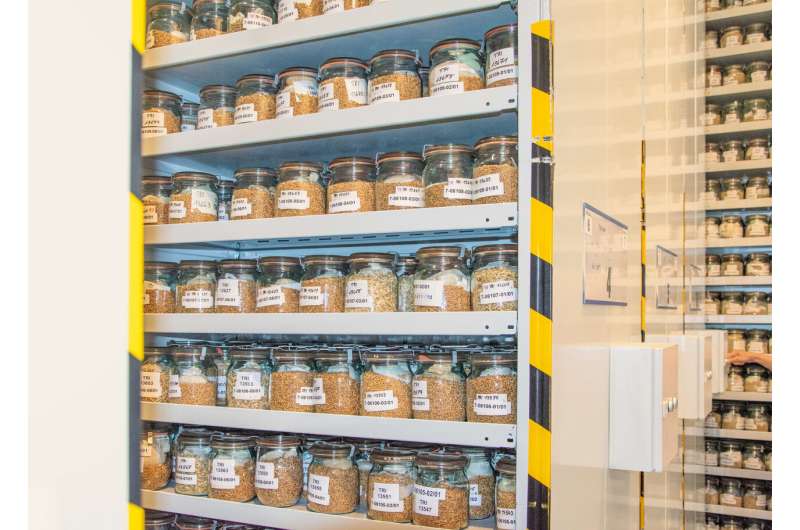Embracing bioinformatics in gene banks

The preservation of plant biodiversity is the task of the roughly 1,750 gene banks distributed around the world. They store plant samples and sometimes additional phenotypic or genetic information of around 7.4 million accessions of plant species in total. It is expected that with facilitated access to improved, quicker and cheaper sequencing and other omics technologies, the number of well-characterised accessions and the amount of detailed information that needs to be stored along with the biological material will grow rapidly and continuously. A team of scientists from the Leibniz Institute of Plant Genetics and Crop Plant Research (IPK) in Gatersleben has now looked ahead into the upcoming challenges and possibilities of the future of gene banks by publishing a perspective paper in Nature Genetics.
In the early to mid-20th century, it became increasingly apparent that crop landraces were slowly being replaced by modern crop varieties and were in danger of disappearing. In order to prevent loss of genetic diversity and biodiversity, the first gene banks were established with the mission to preserve these plant genetic resources. Today, gene banks function as biorepositories and safeguards of plant biodiversity, but most importantly as libraries that turn the genetic plant information and plant material into a freely accessible and valuable resource. As such, scientists, plant breeders and anyone around the world can request and use the data stored within more than 1,750 global gene banks for research or plant breeding purposes.
The Gene Bank of the Leibniz Institute of Plant Genetics and Crop Plant Research (IPK) in Gatersleben currently holds one of the world's most comprehensive collections of crop plants and their wild relatives, collating a total of 151,002 accessions from 2,933 species and 776 genera. The majority of the plant germplasm samples are stored as dry seed at -18°C, while accessions propagated vegetatively are permanently cultivated in the field (ex situ) or preserved in liquid nitrogen at -196°C. The online portal of the IPK gene bank allows users to view and sift through the stored plant accessions and their corresponding passport data, as well as to request plant material on a non-commercial scale. A new perspective paper authored by Dr. Martin Mascher and colleagues of the IPK now examines the current and upcoming challenges for gene banks, and the opportunities for their further advancement.
The scientists identified three major challenges for gene banks that need attention. Two are caused by the basic demands of managing tens of thousands of seed lots, namely, the tracking of the identity of accessions, and the need to avoid unnecessary duplications within and between gene banks. The third challenge is that of maintaining the genetic integrity of accessions, due to the inherent drawbacks of using ex situ conservation such as differential survival, drift and genetic erosion in storage and regeneration.
However, the authors suggest that a stronger genomic-driven approach towards gene banks might help when taking on these challenges. For example, traditionally, the "passport data" of the gene bank material describe the taxonomy and provenance of accessions. By adding single-nucleotide polymorphisms (SNPs) as defining characteristics of an accession, this genotypic information could serve as molecular passport data to complement and correct traditional passport records, as well as assist with the cleansing and prevention of duplicates and improve the quality and integrity of the collections.
By implementing the shift towards bioinformatics and big data analytics in plant sciences, traditional gene banks, which focus on the preservation of germplasm collections, will be able to transform into bio-digital resource centres, which combine the storage and valorisation of plant materials with their genomic and molecular characterisation.
Current funding scenarios of gene banks do not yet allow for the systematic generating of molecular passport data for each submitted plant sample at gene banks. However, first steps into the direction of high-throughput genotyping of entire collections have already been taken. This was previously showcased by an international research consortium led by the IPK, which characterised a world collection of more than 22,000 barley varieties on a molecular level through genotyping-by-sequencing. Some of the authors of the perspective paper had also been involved in this case-study and had contributed to the creation of the web-information-portal BRIDGE as a result. BRIDGE, short for "Biodiversity informatics to bridge the gap from genome information to educated utilization of genetic diversity hosted in gene banks," is a data storage for the attained genomic barley information which links to the phenotypic information collated at the IPK hosted Federal Ex situ Gene Bank for Agricultural and Horticultural Crop Species.
Whilst BRIDGE is already paving the way towards evolving the Gaterslebener Gene Bank into a "one stop shop for facilitated and informed utilisation of crop plant biodiversity," international collaborations, such as the organisation DivSeek, are building the international framework for enabling gene banks, plant breeders and researchers globally to more efficiently process and mobilise plant genetic diversity, thus starting to bridge the gaps between bioinformaticians, geneticists and gene bank curators. Hence, a worldwide network of bio-digital resource centres, sharing data freely and thus help fostering research progress in plant science and plant breeding may become a reality in the near future.
More information: Martin Mascher et al. Genebank genomics bridges the gap between the conservation of crop diversity and plant breeding, Nature Genetics (2019). DOI: 10.1038/s41588-019-0443-6
Journal information: Nature Genetics
Provided by Leibniz Institute of Plant Genetics and Crop Plant Research




















